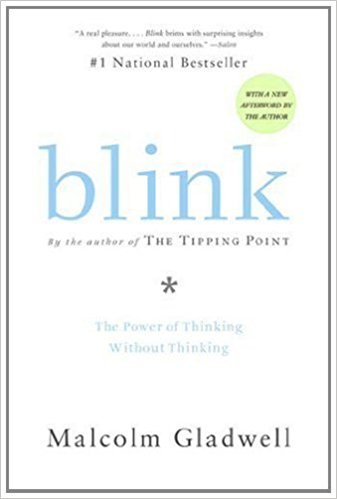 Blink: The Power of Thinking without Thinking by Malcolm Gladwell, Little Brown & Company, 2005.
Blink: The Power of Thinking without Thinking by Malcolm Gladwell, Little Brown & Company, 2005.
There’s so much to say about this relatively short book that I’m going to have a hard time keeping this post to a reasonable length. If you find yourself interested in the book already, then maybe you should go out and get it and not bother reading about it.
Still with me? Okay. You may or may not be familiar with Gladwell, whose other books are well worth reading also. I will probably have a post later on about his newest one, David and Goliath. He can probably best be described as a social psychologist. The premise of Blink is that we are constantly making decisions and coming to conclusions that are intuitive and instantaneous, and that much of the time we’re correct when we do this but there are solid reasons why those instincts can lead us astray.
The introduction is worth reading in its own right, as he tells the story of how the Getty Museum paid $9 million for a supposedly ancient statue that is almost certainly a fake. Why? Mostly because they so wanted the statue to be genuine that they ignored their gut feelings. (I’ve seen this statue in the flesh, as it were, and it sure looks modern to me. The toes look all wrong to my decidedly inexpert eyes.)
Gladwell is especially penetrating on three topics: marriage, racism, and our reactions to stress. He profiles psychologist John Gottman, the originator of the so-called “love lab” where videotaped conversations between couples are analyzed. Gottman can predict with 90 percent accuracy whether or not a couple will get divorced based on just 15 minutes of video in which he and his lab partners watch for fleeting facial expressions. The main predictor of marital failure? Contempt. If you roll your eyes at your spouse, or if he/she rolls his/her eyes at you, watch out!
Racism, unconscious or not, is also an area where quick reactions can show true attitudes. There’s something called the Implicit Association Test that measures how non-discriminatory we really are. The interesting thing is that half of the African=Americans who take the test (including Gladwell himself, who is half black) skew toward stronger positive associations with whites than with blacks. I’ve taken the test myself twice now. (If you’re interested, you can take the test here.) The first time I took it I scored as being neutral; that I had no preference toward either racial group. Well, I was pretty chuffed, let me tell you! I had beaten Malcolm Gladwell! But I just re-took it while in the process of writing this post and this time I scored as having a “moderate” preference toward whites. I wonder if my initial score came about at least partly because I had just read Jay Janz’s blog post, “My Arrest in Ferguson.” (Read that here.)
The third area of special interest in Blink has to do with how our fast-reaction systems fail us when we’re under stress. This book was written long before the recent shootings of black young men by policemen. Instead, it examines a case at the time, the shooting of Amadou Diallo, an unarmed African immigrant, by four policemen. The chapter is titled “Seven Seconds in the Bronx: the Delicate Art of Mind Reading.” Gladwell has masterfully woven the story together from the policemen’s own testimony, and it is clear that even well-trained officers make horrible mistakes when they read a situation wrong. (And those mistakes make life so much harder for the police left in the field; read an excellent article in World magazine about how police forces in various cities are trying to build relationships within their communities even and especially in the wake of all the recent demonstrations.)
So what’s the takeaway? That we have to become aware of how our intuition can be corrupted by our preconceived notions. Blink ends with a chapter telling how classical music auditions changed when screens started being used to keep judges from seeing the performers; suddenly there were more women being hired by symphony orchestras. Now that they could compete purely the basis of ability, those abilities were better recognized. The book ends with a description of one such audition: a woman playing the French horn, an instrument traditionally considered masculine. “But when they declared her the winner and she stepped out from behind the screen, there was a gasp. . . . they knew her. Landsman had played for the Met before as a substitute. Until they listened to her with just their ears, however, they had no idea she was so good. When the screen created a pure Blink moment, a small miracle happened, the kind of miracle that is always possible when we take charge of the first two seconds: they saw her for who she truly was” (254).